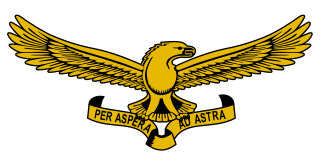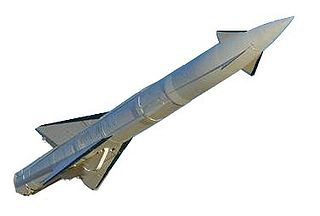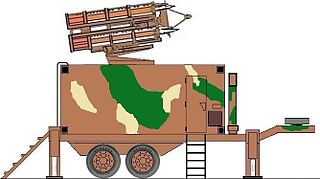
The AIM-54 Phoenix is an American radar-guided, long-range air-to-air missile (AAM), carried in clusters of up to six missiles on the Grumman F-14 Tomcat, its only operational launch platform.

Rapier is a surface-to-air missile developed for the British Army to replace their towed Bofors 40/L70 anti-aircraft guns. The system is unusual as it uses a manual optical guidance system, sending guidance commands to the missile in flight over a radio link. This results in a high level of accuracy, therefore a large warhead is not required.

The South African Air Force (SAAF) is the air warfare branch of South African National Defence Force, with its headquarters in Pretoria. The South African Air Force was established on 1 February 1920. The Air Force saw service in World War II and the Korean War. From 1966, the SAAF was involved in providing infantry support in the low-intensity Border War in Angola, South-West Africa and Rhodesia. As the war progressed, the intensity of air operations increased, until in the late 1980s when the SAAF were compelled to fly fighter missions against Angolan aircraft in order to maintain tactical air superiority. On conclusion of the Border War in 1990, aircraft numbers were severely reduced due to economic pressures as well as the cessation of hostilities with neighbouring states.

The Hughes AIM-4 Falcon was the first operational guided air-to-air missile of the United States Air Force. Development began in 1946; the weapon was first tested in 1949. The missile entered service with the USAF in 1956.

Akash is a medium-range mobile surface-to-air missile (SAM) system developed by the Defence Research and Development Organisation (DRDO) and produced by Bharat Dynamics Limited (BDL). Surveillance and Fire control radar, tactical control and command center and missile launcher are developed by Bharat Electronics (BEL), Tata Power Strategic Engineering Division and Larsen & Toubro. The Akash missile system can target aircraft up to 45 km (28 mi) away. It has the capability to neutralise aerial targets like fighter jets, cruise missiles and air-to-surface missiles as well as ballistic missiles. It is in operational service with the Indian Army and the Indian Air Force.

The Avenger Air Defense System, designated AN/TWQ-1 under the Joint Electronics Type Designation System, is an American self-propelled surface-to-air missile system which provides mobile, short-range air defense protection for ground units against cruise missiles, unmanned aerial vehicles, low-flying fixed-wing aircraft, and helicopters.

The 9K33 Osa is a highly mobile, low-altitude, short-range tactical surface-to-air missile system developed in the Soviet Union in the 1960s and fielded in 1972. Its export version name is Romb.

The 9K31 Strela-1 is a highly mobile, short-range, low altitude infra-red guided surface-to-air missile system. Originally developed by the Soviet Union under the GRAU designation 9K31, it is commonly known by its NATO reporting name, SA-9 "Gaskin". The system consists of a BRDM-2 amphibious vehicle, mounting two pairs of ready-to-fire 9M31 missiles.

The 9K35 Strela-10 is a Soviet highly mobile, short-range surface-to-air missile system. It is visually aimed, and utilizes optical/infrared-guidance. The system is primarily intended to engage low-altitude threats, such as helicopters. "9K35" is its GRAU designation; its NATO reporting name is SA-13 "Gopher".

The Crotale is a French, all-weather, short-range surface-to-air missile system developed to intercept airborne ranged weapons and aircraft, from cruise or anti-ship missiles to helicopters, UAVs or low-flying high-performance fighter aircraft. It was developed by Thomson CSF Matra and consists of a mobile land-based variant as well as various naval ones.

The Raytheon MIM-23 HAWK is an American medium-range surface-to-air missile. It was designed to be a much more mobile counterpart to the MIM-14 Nike Hercules, trading off range and altitude capability for a much smaller size and weight. Its low-level performance was greatly improved over Nike through the adoption of new radars and a continuous wave semi-active radar homing guidance system. It entered service with the US Army in 1959.

The Type 81 Surface-to-Air Missile (81式短距離地対空誘導弾) or Tan-SAM (短SAM) is a Japanese developed surface-to-air missile currently in service with the Japan Ground Self-Defense Force.

The MIM-72A/M48 Chaparral is an American-made self-propelled surface-to-air missile system based on the AIM-9 Sidewinder air-to-air missile system. The launcher is based on the M113 family of vehicles. It entered service with the United States Army in 1969 and was phased out between 1990 and 1998. It was intended to be used along with the M163 VADS, the Vulcan ADS covering short-range short-time engagements, and the Chaparral for longer range use.

The Roland is a Franco-German mobile short-range surface-to-air missile (SAM) system. The Roland was also purchased by the U.S. Army as one of very few foreign SAM systems.
The Denel Dynamics Seeker is an unmanned aerial vehicle (UAV) manufactured in South Africa by Denel Dynamics. The system is designed to perform tactical reconnaissance in real time and can conduct day and night surveillance in all threat environments.

The 2K22 Tunguska is a Soviet tracked self-propelled anti-aircraft gun armed with a surface-to-air gun and missile system. It is designed to provide day and night protection for infantry and tank regiments against low-flying aircraft, helicopters, and cruise missiles in all weather conditions. The NATO reporting name for the missile used by the weapon system is SA-19 "Grison".
List of abbreviations, acronyms and initials related to military subjects such as modern armour, artillery, infantry, and weapons, along with their definitions.

122 Squadron SAAF was a South African Air Force squadron formed in 1970 to operate the South African/French Cactus surface-to-air missile systems in an air defence role. The unit was disbanded when the Cactus system was retired from service in the late 1980s.
The following is a hierarchical outline of the Czechoslovak People's Army at the end of the Cold War. It is intended to convey the connections and relationships between units and formations. At the end of the Cold War in 1989 the Czechoslovak People's Army structure was as follows.

Quick Reaction Surface-to-Air Missile (QRSAM) is a missile developed by the Defence Research and Development Organisation (DRDO), Bharat Electronics Limited and Bharat Dynamics Limited for the Indian Army, meant for protecting moving armoured columns from aerial attacks.





















